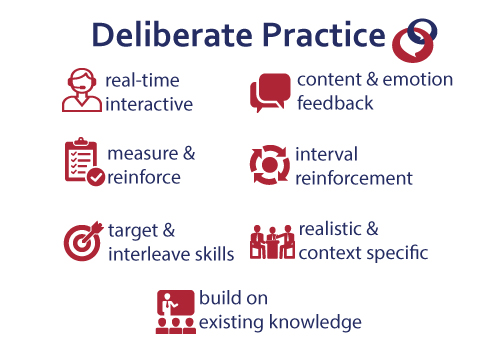
One of the most critical competitive advantages for any organization is the skill level at which its people have important conversations. Interpersonal interactions—whether customer facing, coaching, diversity and inclusion, or leadership—can positively or negatively affect an organization more than a marketing campaign, a recognizable logo, a great product, or a good price. Business leaders look to Learning and Development (L&D) to deliver this competitive advantage across the organization with the expectation of a greater return on their investment every year.
We are about to witness a fundamental shift in the way L&D organizations deliver on this mandate. To be an expert at an interpersonal skill, whether internal or client facing, knowledge of the process is only half of the equation. Converting knowledge into a skill, or crossing the “know-do” gap will be the new strategic objective for leadership and L&D.
L&D traditionally has focused on transferring knowledge to its learners in the form of workshops, e-learning, videos, etc. According to research from the Center for Creative Leadership (CCL), 80 percent of L&D budgets are allocated to these traditional knowledge transfer methods, with 50 percent being instructor-led training (workshops). The evolution of technology has enabled L&D to deliver knowledge from a vast variety of sources to a learner’s preferred device, all at an effective cost. The art of curating content is becoming more and more valuable to organizations. For example, having access to an unlimited number of songs becomes a burden without the aid of curated playlists. L&D organizations have become adept at delivering knowledge to their learners. However, knowledge is not skill.

Converting knowledge into skill traditionally has been the responsibility of the field organization. After learning and absorbing the knowledge, learners are left on their own to increase their skill levels at selling, negotiating, coaching, etc. Some 90 percent of L&D professionals expect managers to take responsibility for skill development after the learner has been trained, according to CCL. Unfortunately, only 15 percent of leaders are satisfied that managers are effectively coaching and developing the skills of learners in the field, according to industry organization ATD. Often, managers’ lack of time, resources, and/or ability—combined with the need to shorten time to value for new methodologies—is shifting that responsibility back to the L&D organization.
Creating and executing a strategy to embrace this shift by offering a complete learning solution that accounts for knowledge transfer and skill development will determine the success of L&D organizations and, ultimately, the businesses they support. Neglecting this opportunity and delivering the “same old” training curriculum will leave organizations exposed and at a competitive disadvantage in attracting and developing top talent. Their talent then will face highly skilled competitors out in the field who have embraced this shift. The L&D organization of the future is focused on deliberate practice as a solution to convert knowledge into skill.
Research into deliberate practice design and execution has increased significantly over the last several years. Researchers such as Mark McDaniel and Anders Ericsson have defined criteria and methodologies that can help guide L&D organizations increase the skill levels of their learners without the risk of practicing on clients.
Applying deliberate practice to a traditional L&D framework will require a new perspective of how learners increase the quality of their skills. Design teams must start by integrating content into scenarios that are realistic and provide targeted opportunities to display measurable skills. Practice scenarios are delivered in a one-to-one safe-practice environment, where the consequence of taking risks or making mistakes is learning and improvement, not lost business. Sessions of one to three scenarios need to be delivered by professional role-player coaches who give feedback on content and process, and, more importantly, on emotional impact. The skills being practiced should be interleaved throughout the scenarios and measured in context. The sessions should be spaced three to 10 days apart to give learners the opportunity to try new skills and begin to forget them (see more about the Forgetting Curve). It is critical that the feedback is received in real time, not pre-recorded; avoid the lure of disguised knowledge transfer such as executive coaching, videos, gamification, and surveys. Practicing is doing—not listening to someone telling you how to do it.
There are also significant budget advantages to delivering a remote one-to-one deliberate practice solution. If designed correctly, remote one-to-one deliberate practice can eliminate travel and the associated loss of time and opportunities.
The concept of practice is not new to L&D organizations. Accepting the challenge and responsibility of implementing deliberate practice as a competitive advantage will highlight which L&D organizations are contributing to success or delivering the “same old, same old.”
Randy Sabourin is co-president of Practica Learning (formerly e-roleplay Inc) and co-founder of Anderson Sabourin Consulting Inc (ASCI). He assists organizations to sustain learning and development investments using a combination of deliberate practice programs and business improvisation. His focus is on how individuals and teams perform under pressure. He combines a unique style of facilitation, coaching, and deliberate practice to help reveal individual behavioral style and its effects on important client-facing, coaching, change, and leadership conversations. Sabourin has published several articles on Deliberate Practicing of Business Skills, Change & Diversity, Business Improvisation, and Training Sustainment; his Leadership Blog is widely read.




